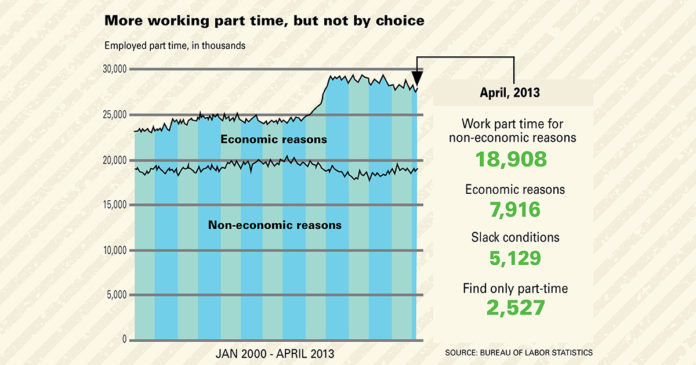
And there are signs the Affordable Care Act-Obamacare-is swelling those ranks as employers prepare to reduce their health insurance coverage responsibility for full time employees.
When the economic collapse began in late 2007, an estimated 24.7 million Americans worked part time. That number now is 27.5 million, about one-fifth of the labor force.
A small share of the part-time growth is fueled by workers’ preferences. They’re juggling school and work, or family and work, or downscaling their work lives as they near retirement. Part-time hours fit their needs.
But according to U.S. Department of Labor household surveys, most of the recent part-time job growth is not by workers’ choice. In the latest national jobs report, covering April 2013, nearly 8 million workers-about one-third of all part-timers-said they were involuntarily part time.
The Labor Department classifies such involuntary part time as “for economic reasons.” That means that only part-time hours were offered because of “slack work or business conditions” or job hunters could find only part-time work.
Indications also abound that employers around the country are turning full-time into part-time jobs to avoid employee health care coverage requirements that will kick in next year.
Chardley Revolus, a 23-year-old Kansas Citian who’s worked for a major retail chain for four years, three weeks ago was told she no longer could work 30 hours or more a week.
“I went to no more than 24 hours,” she said. “They said it was because of health reform.”
Beginning in 2014, businesses that have more than 50 full-time-equivalent employees must offer their full-time workers access to a qualified health care plan or pay a penalty of $2,000 a person. The health care law defines a full-time employee as anyone working more than 30 hours a week.
That is a precedent-setting and low definition of full-time work, a member of the National Federation of Independent Business testified before Congress.
“This is already causing rescheduling of employees where public and private employers have read the law,” said William Gouldin, a business owner who has provided health insurance to his full-time employees.
“Every employer will be forced to define part-time employment as something below 30 hours per week, and most will use between 20 and 27.5 hours per week,” Gouldin testified.
The effect will be that many part-time workers will lose hours and income they’ve been used to getting, or they’ll be forced to add another part-time job to make up the difference.
“The new full-time employee definition will cause a hole in employment,” Gouldin warned Congress.
A study released earlier this year by the University of California-Berkeley Center for Labor Research and Education estimated that 2.3 million workers nationally, or nearly 2 percent of the workforce, are at greatest risk for having their hours cut to below 30 hours a week.
But there are no formal statistics yet to prove that businesses are holding at 49 employees or cutting work hours to stay under the 30-hour rule. A small survey by the Federal Reserve Bank of Minneapolis found 4 percent of companies were moving toward a larger part-time workforce because of health reform.
Some employers have publicly acknowledged they’re cutting workers’ hours because of the Affordable Care Act. Among them: Regal Entertainment Group, which operates Regal Cinemas and United Artists movie screens; a Five Guys franchise owner; an Applebee’s franchisee; the owner of Papa John’s pizza chain; and a Denny’s franchise owner.
Darden, which owns Olive Garden, Red Lobster and LongHorn Steakhouses, announced and then backed off from a plan to reduce full-time workers to part time after a swell of negative national reaction.
The “Obamadodge”
Publicized or not, the part-time trend has become common enough in the service industry that workers have given it a name: the “Obamadodge,” said Mike Enriquez, a labor advocate who’s active in the Kansas City area.
“It’s happening across the board in retail, whether they announce it or not,” Enriquez said.
A grassroots organization called the Retail Action Project earlier this year staged a protest outside a New York City store to protest the conversion of full-time to part-time jobs. The group continues to criticize national retailers for “part-timing” workers that had been full time.
Because of the impending Affordable Care Act requirement, Dennis Jacobe, chief economist for Gallup, said it’s “not a surprise that employers appear to be seeking more part-time workers and fewer full-time employees in 2013.”
That cutback in work hours isn’t good news for employee pocketbooks, he said, or for the overall U.S. economy.
In a recent blog post on Gallup.com, Jacobe wrote: “Having a part-time job takes workers off of unemployment but may leave them under-employed,” and may suggest the labor market is stronger than it really is.
Add in this job market reality:
Some of the biggest job growth in the last couple of years has been in industries with high percentages of part-time workers. That includes food service, retail, temporary help services, health care and other personal services. Most of these relatively low-wage industries have grown about three times as fast as high-paying occupations since 2007.
It’s not just health care Obamacare isn’t the only reason, of course, why workers’ hours are being cut back.
“Global competition has pushed businesses to cut labor costs, either by boosting productivity with technologies that replace workers, or by cutting hours, wages and benefits to create a more ‘flexible’ workforce,” blogged Benjamin Landy, a policy analyst with the Century Foundation, a liberal think tank. “Without strong consumer demand to drive hiring or unions to defend their interests, workers have little leverage in the global economy.”
Economists also note that the rise of women in the workforce has pushed creation of part-time jobs because that’s what many mothers want.
Whatever the cause, there’s no sign of a turnaround in the part-time trend. A national 2011 survey of employers by the McKinsey Global Institute found 58 percent of employers saying they would hire more temporary and part-time workers, and analysts expect the percentage to increase.
“Technology makes it possible for companies to manage labor as a variable input rather than a fixed one,” the McKinsey report said. “Using new resource-scheduling systems, they can staff workers only when needed-whether it’s for a full day or a few hours. In our survey, more than half of employers expected to use more part-time, temporary and contingent workers in the years ahead.”
What’s part time?
The plethora of part-time employment is affecting the length of the average work week. The monthly Labor Department jobs survey for April pegged the length of the average workweek at 34.4 hours. That’s actually improved from an average low of 33.8 hours in 2009, but it continues to show that millions of U.S. workers don’t have a 40-hour work week.
Though the Affordable Care Act sets a 30-hour-a-week full-time definition for employer-based health care coverage, the Labor Department’s household survey allows people to self-report as part time if they usually work less than 35 hours a week. There’s no overriding Labor Department definition of part-time work.
Officially, the department says: “The Fair Labor Standards Act does not define full-time employment or part-time employment. This is a matter generally to be determined by the employer.”
That freedom, in part, has allowed employers to use different part-time definitions. Part-time work can mean 36 hours a week in some companies.
The variations have made it a challenge for some part-time workers to figure out which companies might allow them to participate in employee benefit programs. According to a Kaiser Family Foundation survey, only about one-fourth of companies that offer health benefits open their programs to part-time employees.
As a result, some well-known national companies such as Starbucks, Costco, Land’s End and Whole Foods are flooded with applications because they’re known as employers that allow part-time workers-of varying definitions-to participate in the company health insurance plans.
According to a report published this month by the Employee Benefit Research Institute, 59.6 percent of full-time workers had health care coverage in 2011 through their jobs, compared with 15.7 percent of part-time workers.
“Both have been trending downward since 2007,” wrote researcher Paul Fronstin. “However, in relative terms, part-time workers have experienced a much larger decline in coverage than full-time workers. Between 2007 and 2011, full-time workers experienced a 2.8 percent reduction in the likelihood of having coverage from their own jobs, while part-time workers experienced a 15.7 percent decline.”
Job counselors emphasize that part-time work is better than no work, but it’s a problem if the jobs don’t provide enough money to live on and if few or no employee benefits are attached. Part-time workers in low-paying jobs have trouble paying for basic expenses, much less affording health care coverage, even if they’re eligible to participate in company plans.
Labor market analysts say it’s difficult to track the economic health of part-time workers. The Labor Department’s part-time data are based on a household survey in which workers self-report their status. The squishiness in the data also stems from many workers’ moving into the temporary and contract labor ranks, and such “contingent” labor may be for part-time hours, depending on the project and the week.
The overall part-timing of jobs concerns Mortimer Zuckerman, editor in chief of U.S. News & World Report. A nation of part-time jobs creates an “army of under-utilized labor,” he said in a recent editorial. And he warned:
“From academia to retail, government to warehouse work, employers are increasingly offering part-time work or nominally full-time jobs with lower wages and fewer benefits. Obamacare will accelerate this trend. America’s challenge is to avoid descending totally into a low-wage, part-time economy with stagnant growth and employers pressed to shorten workers’ hours or ask them to take unpaid leave.”
Author: Diane Stafford, The Kansas City Star














